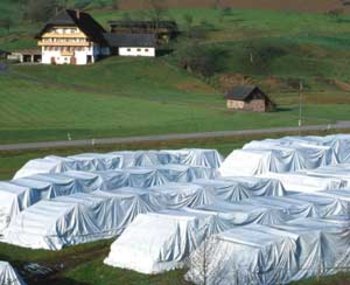Method
The logs are packed in air-tight, usually silage film material. The still living wood cells use up the oxygen inside the packing. Thus, an atmosphere poor in oxygen is created, in which neither wood destroying fungi nor insects can survive. To secure a successful conservation, the oxygen content within the packed stack has to be controlled regularly. After use, the silage film can be recycled or burned.
Click here to download the Spanish translation of this article (PDF-file)
Experiences so far
Conserving the quality of valuable assortments by wrapping them in foil was already attempted after “Wiebke” and “Vivian” in 1991. Encouraged by these good experiences, more than 40,000 cubic metres of spruce, fir, Douglas fir, pine, and beech wood was put into storage after “Lothar” in 2000. Some packages were rejected by the manufacturers due to reduced quality (increased crack formation in beech, wood discolouration, blueness and red stripes and sporadic brown stains and in spruce and fir respectively). Nevertheless, all so conserved timber could be used as was intended at the time of rolling in. As these phenomena were not known from previous studies, it is assumed that the deterioration of quality can be put down to the fact that the timber originated from salvage logging and the (in part) extended time span between cutting and rolling in.
Advantages
- Well protected against insect and fungus infestation;
- Longer storage duration possible, independent of weather, climate, and availability of water;
- Especially applicable if wet storage is not possible.
Disadvantages
- Complex method, high monitoring input;
- Damages to the foil caused by mice, vandalism, and wind may involve expensive repairs;
- Due to the high investment cost, the conservation method is more suitable for valuable logs than as a widely used standard procedure;
- Many sites are not suited for foil conservation. Best results are achieved on flat, windless locations with firm ground conditions.
Preconditions
Timber
- Green, sound soft- and hardwood logs (long and short) can be considered for conservation in silage film, mainly high quality assortments. To reduce packing costs, homogenous lengths are necessary, and packing the logs compactly is advisable.
Packing material
- Standard silage film
- Trained staff
- Drivable depot sites of sufficient size
- Suitable machinery to move the logs
- Two welding devices for sealing the airproof silage film cover
- A measuring device for controlling the conservation success
Storage location
- The method can be applied on sites with firm ground and good transport connections and if possible, in areas which are not highly frequented for recreational use. Especially suitable are paved, concreted or stone paved timber depots of wood processing industries.
- Exposure to wind may lead to wind-induced damage to the foil (breaks and rips).
- Grasslands are usually not suitable, as lorries can’t drive on them after rainfall. Also, the stacks might sink, with their underlying foil, into the wet ground, making it impossible to heat-seal the underlying foil to the cover. Once the stacks are sealed, the sinking movement can lead to cracks in the foil.
- Mice are common in grasslands and can cause a lot of damage. Synthetic grids can help here.
- Vandalism has occurred repeatedly in the past.
Construction
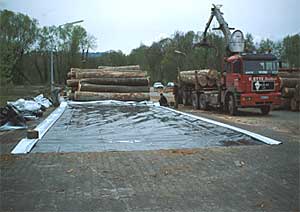
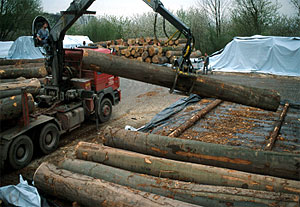
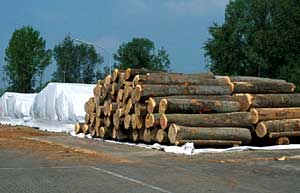
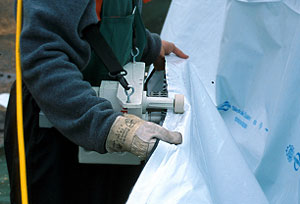
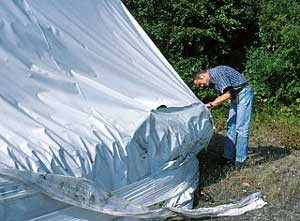
Fig. 2-6: Forest Research Institute Baden-Wuerttemberg, Department for Forest Use.
- The timber has to be protected from air influx from all sides. First, a double layer of silage film is laid out. To avoid damage, the ground has to be cleared of stones and branches.
- A base layer of cross logs is then placed with utmost care onto the foil. Crane handling should only be done by experienced staff.
- After stacking the timber, the edges of the logs on the top layer have to be chamfered and branches cut off neatly to avoid damage to the covering foil, which can then be drawn over the stack.
- The base and cover foil have to be clean and dry when heat-sealing them together.
- Finally, small bands of silage film can be wrapped around the base of the stack for additional protection.
- Stacks should be controlled daily. Damage should be repaired immediately. Even small variations in the gas concentrations in the inner atmosphere can affect or prevent success.
Cost
€ 7.50 to 12.50 per cubic metre roundwood, depending on stack size and design and practice of staff. This includes material and personnel costs. Additional costs for transport and possible leasing costs for storage sites are not included. Costs arising during the storage period for repairing damage (through wind, vandalism, mice,…) are incalculable. They can considerably increase total costs.
Silage film is available in various sizes from cooperative agricultural suppliers. 16 m wide film costs approx. € 3.30 per running metre (exclusive of VAT).
Recommendations
Storing timber under oxygen exclusion can preserve timber quality. However, the method is not applicable for conserving large amounts of timber due to the requirements and restrictions described above. It should therefore be limited to short-term conservation of high quality (hardwood) assortments on sealed surface sites.
The Department for Forest Use of the Forest Research Institute holds more information and advice on this storage method. Preparatory training has to be provided for the concerned staff.
Health and safety: When storing green (still damp) timber under oxygen exclusion in foil, temperatures within the stack rise. Ideal living conditions for mould are the result. A breathing mask should therefore be worn when opening the stack to prevent allergic reactions when inhaling the fungus spores.
Literature
- Bort, U.; Hörger, R. (1991): Konservierung von Holz in kontrollierter Atmosphäre. Versuchsbereichte der FVA Baden-Württemberg, Abt. AWF, Freiburg, S. 1-13
- Brammer, T. (2001): Qualitätsuntersuchungen bei folienkonservierten Furnierbuchen. Versuchsberichte der FVA Baden-Württemberg, Abt WN, Freiburg, S. 1-25
- Gross, M; Mahler, G; Metzler, B. (1992):Ergebnisse der Holzlagerung unter Schutzgas. Versuchsberichte der FVA Baden-Württemberg, Abt. AWF, Freiburg, S. 1-35
- Maier, T. (1995): Alternative Holzkonservierung durch Sauerstoffentzug – Methodik und erste Ergebnisse. Versuchsberichte der FVA Baden-Württemberg, Abt. AWF, Freiburg, S. 1-28
- Maier, T. (1997): Alternative Holzkonservierung durch Sauerstoffentzug – Lagerungsverlauf und Holzqualität bei der Auslagerung. Versuchsberichte der FVA Baden-Württemberg, Abt AWF, Freiburg, S. 1-55
- Maier, T.; Schüler, G.; Mahler, G. (1999):Ganzjährig frisches Rundholz aus dem Lager. In Holz-Zentralblatt Nr. 73 vom 18. Juni 1999. Seite 1092 bis 1094.
- Maier, T.; Schüler, G. (2000): Abschlußbericht zum Forschungsprojekt "Rundholzkonservierung durch Schutzgas" Teilprojekt 2. Forstliche Versuchs- und Forschungsanstalt Baden-Württemberg, 139 Seiten, unveröffentlicht
- Schleier, D.; Püschel, A. (2002): Kann die Folienkonservierung zur biochemischen Borkenkäferbekämpfung eingesetzt werden? Versuchsberichte der FVA Baden-Württemberg, Abt WN, Freiburg, S. 1-27
- Schüler, G. (1998):Alternative Holzkonservierung durch Sauerstoffentzug – Umsetzung in die Praxis. Versuchsberichte der FVA Baden-Württemberg, Abt. AWF, Freiburg. 1-28
- Schüler, G.; Schleier, D.; Mahler, G.; Maier, T. (2001):Rundholzkonservierung in Folie nach "Lothar". Holz-Zentralblatt Nr. 21, 127. Jahrgang, Seite 295
Forest Crises Management Advisory Guide
Back to the main page of the Forestry Crisis Management Advisor Guide: Overview of the different topic collections
Back to the article overview in the: Storm Topic Collection – Coping with Storm Damaged Timber



